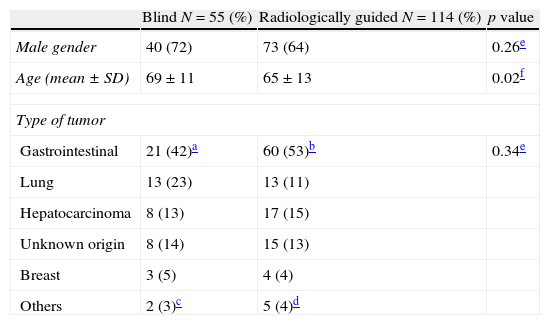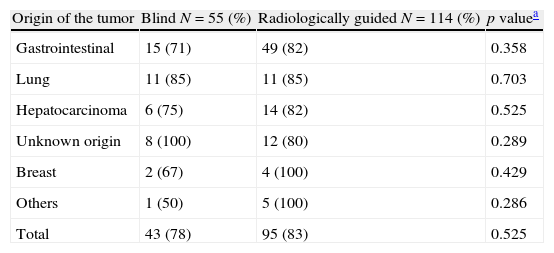In patients with palpable hepatomegaly and space occupying lesions demonstrated by imaging techniques, blind fine needle aspiration puncture (FNAP) at the patient's bedside is feasible.
ObjectiveTo compare the diagnostic yield of the fine needle aspiration puncture (FNAP) performed blindly or under radiological control in patients with hepatomegaly and multiple solid space occupying lesions in the liver, demonstrated by ultrasonography.
MethodsA retrospective study was made of 169 consecutive FNAPs of liver tumors performed either blindly at the bedside by an internist (55 patients) or imaged-guided by a radiologist (114 patients).
ResultsThe diagnostic yield of the technique performed blindly to demonstrate malignancy was 78% (95% confidence interval [CI]: 66–87%) vs. 83% (95% CI: 75–89%, p=.42) obtained in the image-guided FNAPs. The diagnostic yield did not vary based on type of tumor invading the liver.
ConclusionBlind FNAP procedures in patients with palpable enlarged liver due to solid space occupying lesions is as effective as those performed under radiological control.
En los pacientes con hepatomegalia palpable y lesiones ocupantes de espacio demostradas por técnica de imagen es factible realizar la punción-aspiración con aguja fina (PAAF) a ciegas a la cabecera del paciente.
ObjetivoComparar la rentabilidad diagnóstica de la PAAF realizada a ciegas o bajo control radiológico en los pacientes con hepatomegalia y múltiples lesiones ocupantes de espacio sólidas en hígado, demostradas por ecografía.
MétodosEstudio retrospectivo de 169 PAAF consecutivas de hígados tumorales, realizadas a ciegas en la cabecera del paciente por un internista (55 casos) o guiadas por imagen por parte de un radiólogo (114 casos).
ResultadosLa rentabilidad diagnóstica de la técnica realizada a ciegas para demostrar malignidad fue del 78% (IC 95%: 66-87%) vs. 83% (IC 95%: 75-89%; p=0,42) obtenido en las PAAF guiadas por imagen. La rentabilidad diagnóstica no varió en función del tipo de tumor que invadía el hígado.
ConclusiónLa PAAF a ciegas en los pacientes con hepatomegalia tumoral palpable debida a LOES múltiples es tan eficaz como la realizada bajo control radiológico.
Article
Diríjase desde aquí a la web de la >>>FESEMI<<< e inicie sesión mediante el formulario que se encuentra en la barra superior, pulsando sobre el candado.

Una vez autentificado, en la misma web de FESEMI, en el menú superior, elija la opción deseada.

>>>FESEMI<<<







